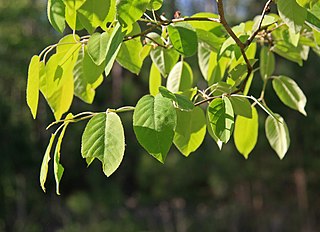
Erica arborea, the tree heath or tree heather, is a species of flowering plant (angiosperms) in the heather family Ericaceae, native to the Mediterranean Basin and Ethiopia, Kenya and Tanzania in East Africa. It is also cultivated as an ornamental.

The American tree sparrow, also known as the winter sparrow, is a medium-sized New World sparrow.

The West Indian whistling duck is a whistling duck that breeds in the Caribbean. Alternative names are black-billed whistling duck and Cuban whistling duck.

Amelanchier arborea, is native to eastern North America from the Gulf Coast north to Thunder Bay in Ontario and Lake St. John in Quebec, and west to Texas and Minnesota.

Gmelina arborea,, locally known as gamhar, is a fast-growing deciduous tree in the family Lamiaceae.

Theophrastoideae is a small subfamily of flowering plants in the family Primulaceae. It was formerly recognized as a separate family Theophrastaceae. As previously circumscribed, the family consisted of eight genera and 95 species of trees or shrubs, native to tropical regions of the Americas.

Jacquinia pungens is a species of flowering plant in the family Primulaceae, native to southern Mexico. It is a shrub growing to 4 m tall, with lanceolate to oblong evergreen leaves 4–7 cm long, with a sharply pointed apex. The flowers are yellow, orange, or red, produced in tight racemes. The fruit is a yellow berry.

Careya arborea is a species of tree in the Lecythidaceae family, native to the Indian subcontinent, Afghanistan, and Indochina. Its common English names include wild guava, Ceylon oak, patana oak. Careya arborea is a deciduous tree that grows up to 15 metres (49 ft) high. Its leaves turn red in the cold season. Flowers are yellow or white in colour that become large green berries. The tree grows throughout India in forests and grasslands.

Psoralea arborea is a species of legume in the family Fabaceae. It is a shrub or tree endemic to the Cape Provinces of South Africa.

Dubautia arborea, the tree dubautia or Mauna Kea dubautia, is a species of flowering plant in the family Asteraceae. A member of the silversword alliance, it is endemic to the island of Hawaiʻi. It is a shrub or small tree. It is an endangered species that is threatened by feral grazing animals.
Buxus arborea is a species of plant in the family Buxaceae. It is endemic to Jamaica. It is threatened by habitat loss.
Prunus arborea is a species of plant in the family Rosaceae. It is found in Indonesia, Malaysia, Singapore, and Thailand.

Malva arborea, the tree mallow, is a species of mallow native to the coasts of western Europe and the Mediterranean region, from Ireland and Britain south to Algeria and Libya, and east to Greece.

The Guajira–Barranquilla xeric scrub is a xeric shrubland ecoregion in Colombia, Venezuela, and the ABC Islands, covering an estimated area of 150,000 km2 (58,000 sq mi). Rainfall varies from 125 to 600 mm, and the median temperature is 26 °C (79 °F).

Phylica arborea, also known as the Island Cape myrtle, is a shrub or small tree with narrow needle-like dark green leaves, downy silver on the underside, and with greenish white terminal flowers. Usually a shrub or procumbent tree, it may reach 6–7 m in height in sheltered locations. It is found on various isolated islands, including the Tristan da Cunha group and Gough Island, in the South Atlantic Ocean, as well as Amsterdam Island in the southern Indian Ocean.

Brugmansia arborea, the angel's trumpet, is a species of flowering plant in the family Solanaceae. The IUCN has classed Brugmansia arborea as Extinct in the Wild.

Clethra arborea, commonly known as the lily-of-the-valley-tree, is a flowering plant in the genus Clethra. It is found in Macaronesia where it is native to Madeira, extinct in the Canary Islands, and considered an introduced species in the Azores. In Madeira its natural habitat is laurisilva forest.

Passiflora arborea is a species of passion flower found in Colombia, Ecuador and Panama. Passiflora arborea is a freestanding tree that can grow to be 50 feet tall. They germinate anywhere from an elevation of 1400 – 2000 ft. The tree's leaves grow to be 1 to 1½ feet long. It is native to Colombia, is rarely seen in cultivation, and is one of two species of Passiflora that is not widely distributed throughout the country.

Kopsia arborea is a tree in the family Apocynaceae.

Jacquinia keyensis, commonly called Joewood, is a woody plant in the primrose family. It is native to the West Indies, where it is widespread on many islands. Its natural habitat is coastal strand, often on coral exposures with salt spray.

















